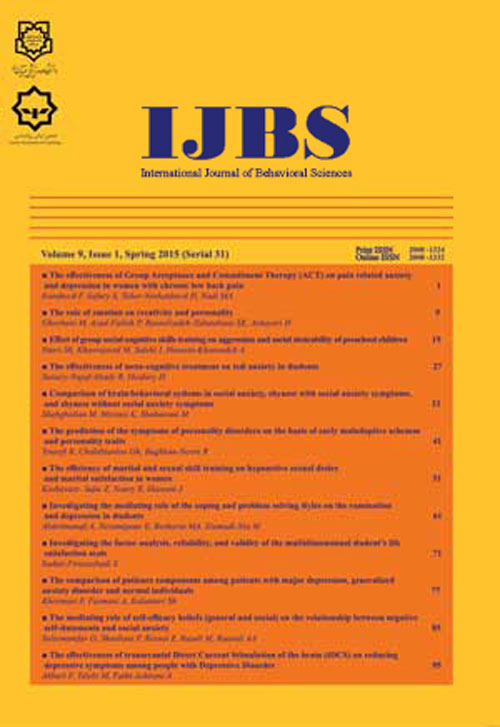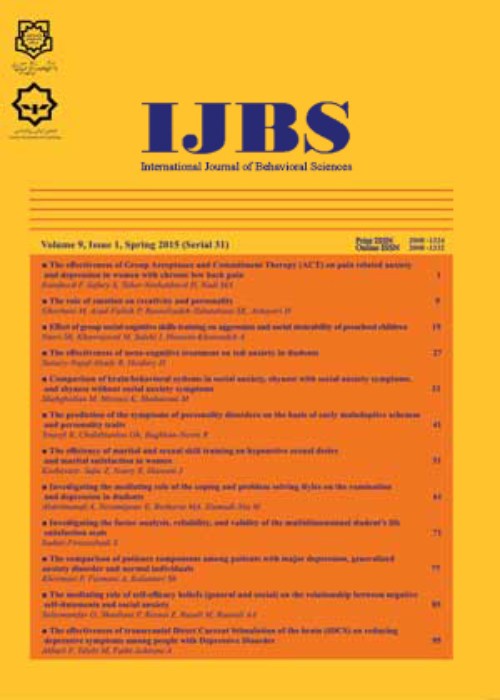فهرست مطالب

International Journal of Behavioral Sciences
Volume:13 Issue: 3, Autumn 2019
- تاریخ انتشار: 1398/08/10
- تعداد عناوین: 7
-
-
Pages 92-96Introduction
Narcissism, psychopathy, and Machiavellianism, collectively referred to as the Dark Triad, are sub-clinical personality traits that have been linked to a number of negative outcomes such as antisocial behaviors. This research examined how these Dark Triad personality traits differ in their relationships with well-being.
MethodThe Persian versions of the 27-item Short Dark Triad, the 5-item Satisfaction with Life Scale, the 4-item Subjective Happiness Scale, and the 42-item version of Ryff’s Scales of Psychological Well-being were administered to a sample of 228 Iranian university students. Using SPSS, Pearson correlation coefficient, and regression analyses were applied to analyze the data.
ResultsAccording to the results of this study, narcissism was positively related to both psychological and subjective well-being. On the other hand, psychopathy and Machiavellianism were related to lower levels of well-being. Narcissism was the strongest predictor of personal growth, self-acceptance, and happiness. Psychopathy was the strongest predictor of environmental mastery, positive relations with others, and purpose in life. Finally, Machiavellianism was the only predictor of autonomy.
ConclusionThis research, depicting the independent contributions of the Dark Triad personality traits to well-being, suggested that having a sub-clinical narcissistic personality is good for living a fully functioning life.
Keywords: Machiavellianism, Narcissism, personality, Psychopathy, Well-Being -
Pages 97-103Introduction
Based on the cognitive model, Obsessive-Compulsive Disorder (OCD) is maintained by various belief factors. Despite much support for this hypothesis, little is understood about the role of self-concept in the maintenance or treatment of OCD. Researchers believe that individuals who are ambivalent about their self-worth, use OCD-related beliefs and behaviors to restore self-esteem. The present study investigates the association between self-ambivalence and OCD-related beliefs and symptoms. Also, it is expected that OCD-relevant beliefs mediate the association between self-ambivalence and OCD symptoms.
MethodNon-clinical participants (280) were recruited for this research. Each participant completed the self-reported versions of the Yale–Brown Obsessive Compulsive Scale (Y-BOCS), the Self-Ambivalence Scale (Y-BOCS), and the Obsessive Beliefs Questionnaire-44)OBQ-44). The data were analyzed using path analysis in SPSS 18.
ResultsFindings revealed that self-ambivalence had a significant positive correlation with OCD-relevant beliefs and OCD symptoms. The OCD-relevant beliefs also showed a significant positive association with OCD symptoms. Analysis of the data revealed that OCD-beliefs mediated the relationship between self-ambivalence and OCD-symptoms.
ConclusionResults indicate that individuals who are ambivalent about their self-worth, develop a morally and socially ideal self and relevant beliefs to resolve the self-ambivalence. These beliefs create a vulnerability for developing OCD. To conclude, interventions addressing the self-ambivalence and OCD-relevant beliefs can be effective in the prevention and treatment of OCD.
Keywords: Obsessive Compulsive Disorder, Self-ambivalence, Obsessive Beliefs -
Pages 104-110Introduction
This study investigated the relationship between psychological capital and job performance by focusing on the mediating role of psychological empowerment.
MethodThe present study used a correlational method through Structural Equation Modeling (SEM). In order to do so, 204 employees were selected through the stratified sampling method. To collect data, the study drew on such instruments as Luthans and Colleagues’ Psychological Capital Questionnaire, Paterson's Job Performance Questionnaire, and Spreitzer and Mishra’s Psychological Empowerment Questionnaire. The data were analyzed with reference to correlational statistics and inferential statistics processed in SPSS-23 and Lisrel-8.5 software. Analyses of the SEM confirmed that the proposed model fit the data.
ResultsThe findings revealed that psychological capital had a significant effect on both job performance (%35) and on psychological empowerment (%69). Furthermore, the effect of psychological empowerment on job performance (%54) was significant. The effect of psychological capital on job performance through the mediation of psychological empowerment was also significant (%37).
ConclusionAs the results showed, it can be argued that organizations could reinforce their competitive status by investing on and paying attention to the positive psychological features of their Human Resources (HR), and by taking the necessary measures to enhance these characteristics, as they could contribute to organizational performance and productivity.
Keywords: Psychological Capital, Psychological empowerment, job performance, Structural Equation Modeling (SEM) -
Pages 111-116Introduction
Increase in the prevalence of hypertension has become a major health problem nowadays. It seems that psychological factors are involved in this chronic disease. The aim of the current research was to compare the health promotion lifestyle and the health locus of control in both individuals with hypertension and healthy individuals.
MethodThe present study was a causal-comparative research in which 100 healthy individuals and 100 individuals with hypertension were selected through convenience sampling. To gather the data, the Health Promoting Lifestyle Profile (HPLP) and the Multidimensional Health Locus of Control (MHLC) were used, and data were analyzed by independent t-test.
ResultsFindings indicated that among the subscales of lifestyle, there are significant differences between the subscales of physical activity (p < 0.01), nutrition (p< 0.01), and interpersonal relationship (p < 0.01) in both groups. In terms of health locus of control, there are significant differences in the subscales of chance control (p < 0.01) and external locus of control (p< 0.01).
ConclusionAccordingly, health promoting lifestyle and health locus of control are two main psychological constructs related to hypertension. Therefore, focusing on these factors can be useful in the prevention and treatment of this chronic disease.
Keywords: Hypertension, Health-Promoting Lifestyle, Health locus of control -
Pages 112-117Introduction
Intimacy has a fundamental importance in the survival of couples' relationships and its rate has a profound effect on marital happiness. The main objective of the present research was to investigate the effectiveness of cognitive-behavioral couple therapy as well as emotion-focused couple therapy on marital intimacy of couples referring to counseling centers in the city of Zabol, Iran.
MethodThe current research was a quasi-experimental study with a randomized placement of subjects. The plan of the pre-test and post-test groups as well as control group with two experimental categories were used in this research to test the hypotheses. The statistical population included all couples referring to Zabol counseling centers during 2017-2018. The sample consisted of 24 couples (48 individuals) who were selected through targeted sampling and were randomly divided into three groups (each group with 8 pairs), namely, two experimental groups (cognitive-behavioral couple therapy and emotion-focused couple therapy) and a control group. The data were collected by questionnaire of Bagarozzi intimacy. Then, the collected data were analyzed according to covariance analysis (one way and multivariate method).
ResultsAccording to the findings, both types of cognitive-behavioral couple therapy as well as emotion-focused couple therapy were effective in increasing marital intimacy. Also, both types of couple therapy were effective in promoting marital performance.
ConclusionTo conclude, the effect of cognitive-behavioral couple therapy and emotion-focused couple therapy is different with each other in improving marital performance and marital intimacy between couples.
Keywords: Emotion-Focused Couple Therapy, Cognitive-Behavioral Couple Therapy, Marital Intimacy -
Pages 118-122Introduction
The present study has aimed to investigate the effectiveness of the time-perspective training on time-balancing and self-regulation among grade 9 female students living in Tehran.
MethodThis research was a semi-experimental research with a pretest-posttest and follow-up design and a control group. The statistical population consisted of all grade 9 female students without Balanced Time-Perspective (BTP). The samples were chosen randomly from high-school students and were then divided into control and experimental groups. The members of the experimental group experienced the time-perspective training sessions and then the results were compared to those of controls. Zimbardo Time Perspective Inventory (ZTPI) and Academic Self-Regulation Questionnaire (SRQ-A) were used for gathering data. Also, data was analyzed using descriptive and inferential statistics of variance for repeated measures ANOVA and post hoc Bonfroni test was used at α= 0.05 through SPSS Ver.22 software .
ResultsFindings revealed that time perspective training had an effect on the time balancing and academic self-regulation of students and there was a significant difference between the two groups (p <0.0001) while such an effect remained in the two-month follow-up phase (P<0.0001).
ConclusionThe therapists are recommended to use time-perspective training among the students in order to provide their future with better psychological health.
Keywords: Time-perspective Training, Balanced Time Perspective, Time-Balancing, academic self-regulation -
Pages 123-128Introduction
The aim of the present study was to investigate the predicting role of the big five personality traits in the four components of moral decision-making.
MethodThe population of this descriptive-correlation study included all the students in the University of Mazandaran. The participants were 384 students selected by stratified random sampling. In order to collect data, the Mini-IPIP, Ethical Sensitivity Scale, DIT-2, Moral Identity Questionnaire and the Moral Courage Scale were used. The data were analyzed by SPSS-24.
ResultsAccording to the results of this study, neuroticism was a negative significant predictor of moral identity and moral courage, extraversion was a negative significant predictor of moral identity, openness was a positive significant predictor of moral identity, agreeableness was a positive significant predictor of moral sensitivity and moral identity and conscientiousness were a positive significant predictor of moral identity, and moral courage.
ConclusionAccording to the results of the present study, it can be stated that different personality traits can predict different aspects of moral decision making.
Keywords: personality traits, Moral sensitivity, Moral Reasoning, moral identity, Moral Courage


